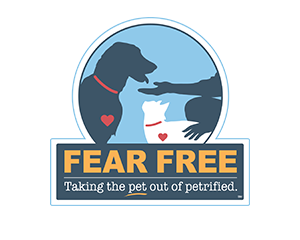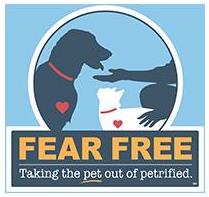
June 2019 – How to Recognize Pet Cognitive Dysfunction Syndrome
As our pets age, they sometimes can develop a form of dementia known as Cognitive Dysfunction Syndrome (CDS). This is also thought of as the canine and feline equivalent of Alzheimer’s disease in people. Although not all dogs and cats develop dementia, many will develop some degree of cognitive decline after age eleven.
In one international survey, an estimated 14.2% of older dogs suffered from canine cognitive dysfunction (CCD). The study also found that only 2% of the dogs with clinical signs consistent with CCD had been diagnosed as such by a veterinarian. Why? Pet owners may fail to report symptoms to their veterinarian because they don’t recognize the symptoms.


It’s important to note that if signs of cognitive dysfunction are recognized early, there are many interventions that can be taken to help slow the progression and sometimes reverse the symptoms.
Signs of cognitive dysfunction in cats and dogs (DISHAI):
- Disorientation: Wandering from room to room or staring blankly at a wall or just into space
- Interaction changes: Extremes in affection or detachment
- Sleep changes: Wandering at night accompanied by increased vocalization (in cats)
- Housesoiling or soiling outside the litter box
- Activity level changes
- Increased anxiety
If you suspect your pet is suffering from cognitive dysfunction, fill out this Questionnaire and take it along to your next veterinarian appointment. The first thing your veterinarian will do is rule out medical causes, such as arthritis for missing the litter box. Like many behavioral diseases, a diagnosis of cognitive dysfunction is a diagnosis of exclusion – rule out medical causes first and then consider other behavior conditions.
If it is concluded that cognitive dysfunction is an issue, it may become necessary to increase your pet’s medical exams to twice a year to stay on top of any developing medical issues that might be exacerbated by CDS. Management of CDS symptoms can include adjustments in their diet, adding supplements, enhancing environmental enrichment (such as walks, interactive toys, and training) or administering medications. There is no cure for CDS, but the progression can be slowed down.
Your veterinarian may recommend foods and supplements to boost your pet’s intake of antioxidants, vitamins A, C and E, fatty acids, and L-carnitine. Several diets containing a combination of these supplements may help support the pet’s cognitive functioning.
Your veterinarian may also recommend situational anti-anxiety or sedating medications that are safe and can be used in mild or stronger doses for problems such as nighttime waking if this becomes a problem for the owner.
Mental enrichment is highly beneficial for CDS. Brain chemistry changes that occur after enrichment activities are similar to what happens in the brain when an antidepressant is taken. Exercise is vital, and pheromone therapy and classical music can also have calming effects. Even simple car rides or rides in strollers can help. Try puzzle toys and scent games to keep your pet’s mind engaged and stimulated.
Most importantly, stay positive as your pet ages. You can help them through their golden years with veterinary advice and good home management.
Recommended Reading:
Nutritional Assessments for Dogs and Cats
How Fatty Acids Can Improve Your Pet’s Health
Keeping Your Pets Fit With Regular Exercise
Why Environmental Enrichment is Important for Cats
Belle Mead Animal Hospital, Your Other Family Doctors
Handling Every Pet with Love Every Day!
As Certified Fear Free Professionals, our Mission is to prevent and alleviate fear, anxiety and stress in pets by inspiring and educating the people who care for them.


LIKE us on Facebook and Follow us on Twitter @BMAH121 and Pinterest for news and pet wellness tips. We’re also on YouTube! Subscribe for updates! Tag and Follow us on Instagram!








